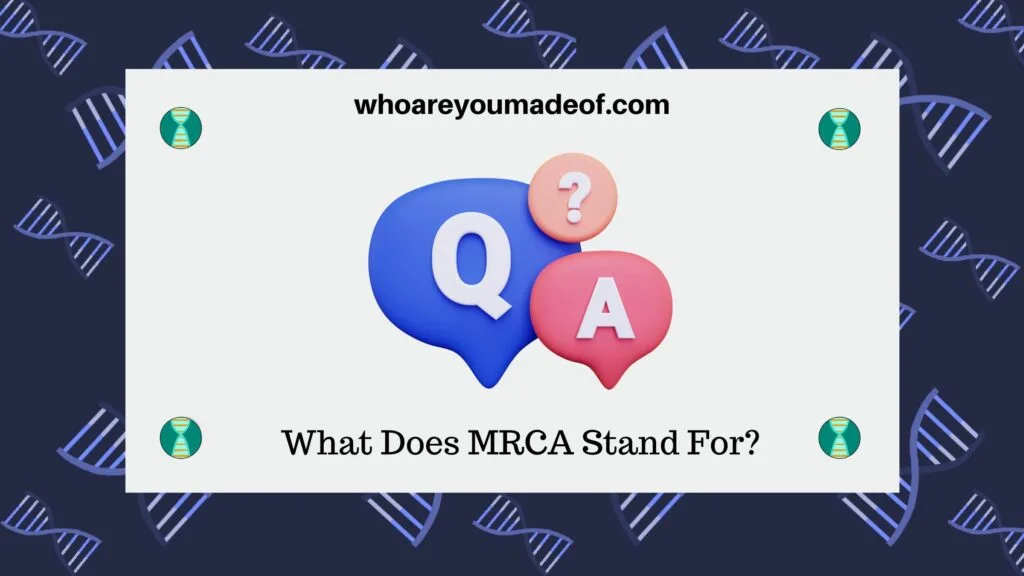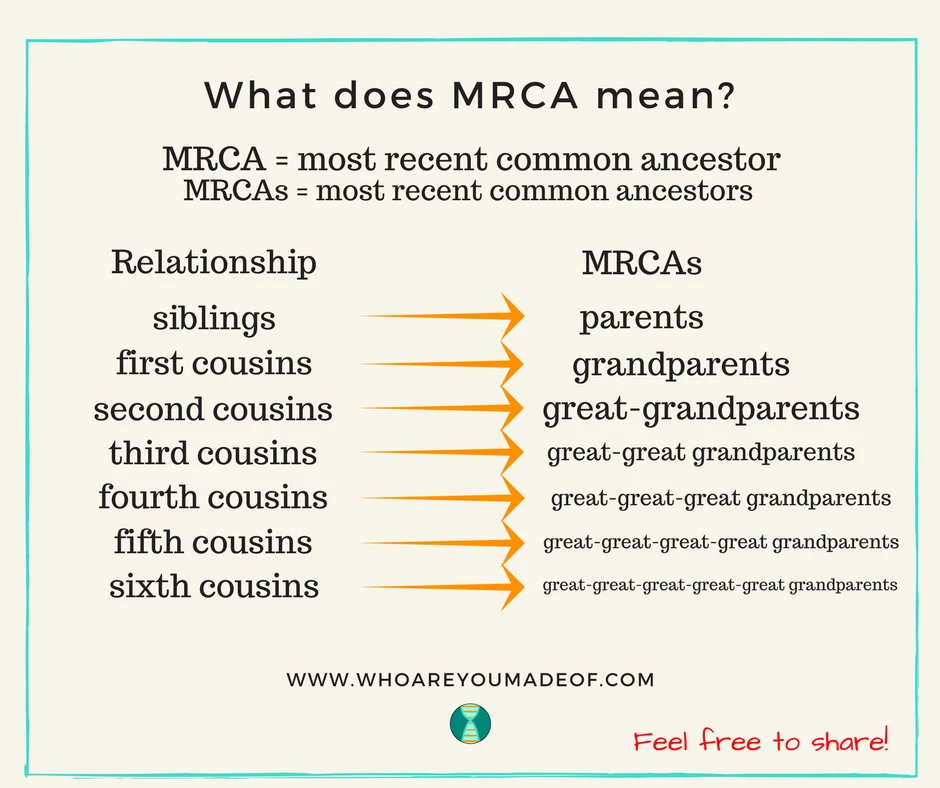MRCA is of the most common notations used in genealogy. In this post, learn what these letters stand for in the definition of MRCA.

If you’ve been doing this whole family tree research thing for a while, you might have seen the letters “MRCA”. It’s especially common to see this in the genetic genealogy sphere – and for good reason.
You might see MRCA used in genetic genealogy, specifically when used to refer to how we are related to DNA matches. However, we even see this term pop up in traditional family tree research.
What does MRCA stand for?
MRCA stands for “Most Recent Common Ancestor”. You might also see it written as “MRCAs”, which is the plural form, often used when the most recent common ancestors are a married couple, such as both grandparents.
Simple enough, right? It is a pretty straightforward term. Your most recent common ancestor is the most recent person that you and another person are related to.
More on this below. The plural form, MRCAs, is when you share a set of common ancestors in the same generation – which is actually usually the case, as in when you share both great-grandparents, or some other married couple in your family tree.
You will sometimes see LCA instead of MRCA. LCA means “last common ancestor”. In my opinion, MRCA is easier to remember because it’s meaning is more clear. That’s just me!
What does “Most Recent Common Ancestor” mean?
Most Recent Common Ancestor (MRCA) stands for the most recent person that you and your family member are descended from. It is important to define the most recent ancestor that you share because this is how you can calculate the “type of cousin” that you and your relative have.
The reason that we need to focus on the most ancestor that you share is because you and your relative could potentially be related in more than one way, but the relationship based on the most recent ancestor is going to be more significant genealogically.
Furthermore, since you and your relative share all of the ancestors of your most recent common ancestor, it’s important to note the closest ancestor to both of you on that line of your family tree.
I have three examples below to help illustrate this concept.
Who is the MRCA for first cousins?
The MRCA for first cousins is one or both grandparents. Full first cousins share both grandparents as the most recent common ancestors, and half-first cousins will share only one grandparent as the MRCA.
I have a first cousin named Jane on my mom’s side of the family. We are both related to both of my mom’s parents, since her dad is my mom’s full brother.
This means that we have MRCAs of Grandma and Grandpa on that side. The MRCAs of Jane and I are grandma and grandpa, but we are both related to all of the ancestors of those grandparents.
All of those ancestors are common ancestors that Jane and I share, but the most recent ones (MRCAs) are grandma and grandpa.
Who is the MRCA for second cousins?
The most recent common ancestor shared between second cousins is at least one great-grandparent. In the case of when two second cousins share both great-grandparents, their MRCAs are the great-grandparents.
The grandparents of the second cousins are siblings who were offspring of the great-grandparents.
1/2 2nd cousin once-removed – who is the MRCA?
We share a “most recent common ancestor”, or a MRCA, with all of our relatives, even those cousins who are half-cousins generations removed, such as a 1/2 second cousin once-removed.
One of my favorite cousins is a 1/2 2nd cousin once-removed. Let’s call him “Jay”. Jay and my mother are second cousins.
Full second cousins share great-grandparents. Since my mother and Jay are half-second cousins, this means that they only share one great-grandparent.
In this case, they share a great-grandfather. Jay’s great-grandmother died, and their great-grandfather remarried to my mother’s great-grandmother.
The MRCA is the great-grandfather of Jay and my mother. Jay and I are second cousins once-removed, since I am one generation further away from the MRCA.
Who is the MRCA for third cousins?
The MRCA, or most recent common ancestor, for third cousins, is the great-great grandparents of the third cousins. You can share only one great-grandparent with a third cousin, or two, in which case the shared great-grandparents would be MRCAs.
Fourth cousin – who is the MRCA?
We have most recent common ancestors, or a MRCA, shared with all of our relatives, even our distant cousins. Fourth cousins and more distant cousins will share a MRCA with us who is at least as distant as a great-great-great grandparent.
Most people have a ton of fourth cousins. You share great-great-great grandparents with any given fourth cousin.
This means that the MRCAs for a fourth cousin are your great-great-great grandparents. Your child’s relationship to the fourth cousin is a fourth cousin once-removed, but the MRCAs are still the same.
Your children and the children of the fourth cousins will now be fifth cousins (since they share great-great-great-great grandparents), but the MRCAs stay the same.
I made this image just for you – feel free to share it!
How should I use MRCA in my own research?
I love to use MRCA when I’m going through my DNA matches. As soon as I spot how we are related, I usually make a quick notation as a note on the match profile.
I’ll note who the MRCA is, or who I think it is. It’s way quicker than writing down “we are related through my great-great-great grandfather William Smith and his second wife, Bessie”. Instead, I’ll just write “MRCA Smith/Bessie”.
If we are only related through my great-great-great grandfather William Smith (but not through Bessie), I’ll write simply “MRCA William Smith”.
You can also use this acronym in communicating with others, since it takes less time and space (text messages or Twitter, anyone?).
Conclusion
I hope this article helped you figure out what MRCA means and how it can help you be more efficient in writing your notes on your family tree.
Thanks for stopping by!



How Much DNA Do We Share With Our Ancestors? - Who are You Made Of?
Thursday 18th of February 2021
[…] What we do know is that we can share very small amounts of DNA with our third cousins, and those cousins are descended from our great-great grandparents (our most recent common ancestor). […]
How to Know if You Have Endogamy in Your DNA Matches - Who are You Made Of?
Wednesday 11th of November 2020
[…] most people will not be able to identify all of these individuals. They are most likely to know the most recent common ancestor, but not all of the common […]